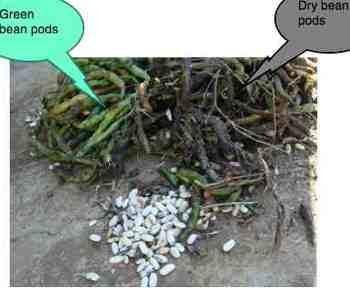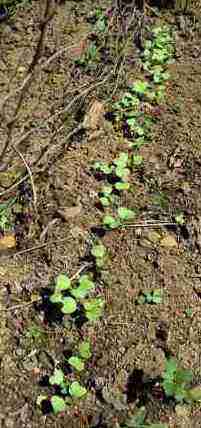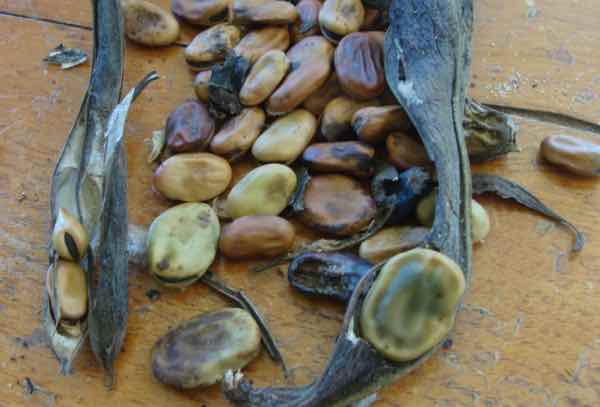- Bernard Preston homepage
- Legumes
- Save Bean Seeds
Save Bean Seeds
Save bean seeds and you'll find yourself with extra dollars in your pocket; perhaps quite a lot of them.
Plus when your favourite bean suddenly goes out of vogue, as this Witsa has, you will still have it available. Seed-companies have brought out newer varieties, supposedly better but in our opinion often not; but more profitable for them. The only problem with progress is that it's not always a step forwards.

This page was last updated by Dr Bernard Preston on 9th January, 2024.
At the end of summer unless you are extremely vigilant which I am not, you'll find that you have missed reaping a few pods. Now they are mature, hard and stringy; and the beans are starchy.
They are too old to enjoy as tender young delicious green string-beans. So what do you do with them?
That's easy; here you can see a pile of string bean pods that I picked whilst cleaning the vines off the trellis in preparation for the next crop.
I quickly divided my string beans into two.
- Dried out pods
- Green pods
Save Bean Seeds
The green pods went straight into the dogs' food. Cooked up with rice, an extra butternut and potato peels, they make an excellent meal for your pets too. With raw beef added, they ate the lot! There is no need to save bean seed from immature fruit.
I do not know enough to enter the debate as to whether dogs should only eat red meat and nothing else.
Now for the dried out pods; they're a greyish colour. The best ones, when they are properly dry shake, rattle and roll; in the vernacular they sing. The others are okay but you should leave them in the sun for a few days. Otherwise they get mildewy and will go rotten.
"Don't plant just one variety of bean in the spring; instead, set five or more different types. Then you can compare their vigor, productivity and disease resistance; also their length of harvest and flavor."
- David the Good
Once dry, crack them open and prize out the beans. Together with the vines, the pods are perfect for making a compost pile. Just chuck them on and keep adding layers of vegetable matter from the garden and kitchen.
Keep only those bean seeds that are perfect. Those which are discoloured, chipped or undersized you should discard; more dog food.
Bad seeds will only give you weak plants next season.
I place them out in the hot sun to dry out completely; and kill any beetles.
Then
simply place them in a bottle, remembering to label it; put it
away in a dry and dark spot, ready for the next planting. Actually they will keep for years.
Going to seed is a natural part of the cycle of nature but it does come with a few pangs. The beets have become hard and woody and should have been harvested a few weeks earlier. Lettuce leaves will be turning bitter and very soon there'll be no more tender young spinach leaves.
Where you eat the seed, naturally you'll be delighted, as in how to grow corn.
Save been seeds because it's the ninth of the ten commandments of food security.
Nitrogen fixation
Nitrogen fixation is an essential part of the organic garden. Inoculating rhizobia onto legume seeds makes a huge difference to the yield; and the fertiliser left in the soil.
Legumes fix nitrogen in the soil from the atmosphere so, once you've pulled the beans after picking the dried pods immediately plant another crop.
Here you can see a row of radish growing along the bean trellis.
The dead bean plants along with their roots go straight into the compost pile to seed that too with nitrogen fixation bacteria.

Growing green Beans
Once the danger of frost is over, as green beans are very sensitive dig a trench alongside a trellis-work or fence. Fill half of it with compost and then cover it well with at least 6 inches of soil to minimise the danger of cutworms.
Now that we have hens we allow them to dig through the loose soil thoroughly to devour any bugs; especially for the Mexican bean beetle larvae.
Plant the seed that you've saved about 5 centimetres apart in the row; and 2cm deep. Cover them with soil and go get a good Bernard Preston book. There's nothing more to be done, except perhaps to weed them. In 2 to 3 months you will have green beans coming out of your ears.
Should you grow dwarf or pole beans?
I recommend you grow both. First thing in the spring, plant out a bed of dwarf green beans; they'll be ready in about eight weeks. Then put up a trellis of sorts and sow a row of the pole variety. They will take longer but bear for several months, more prolifically and are easier to pick. Save your back, Jack.
Every six weeks, plant out another row of pole beans. Don't bother with the bush variety again until next spring. We have put them in five times this summer, and we are still enjoying them every day in April; late autumn in the Southern hemisphere.
Cooking String Beans
Nothing could be easier than COOKING GREEN BEANS. Pick the nice young pods, top 'n tail, and drop them into boiling water; five minutes maximum or less if you like them al dente.
Witsa is not stringy so it's a bit of a misnomer.
Broad bean seeds

Save your broad bean seeds too. Oddly we find they germinate far better than those purchased from the nursery; that's if you can get them at all.
Broad beans have three advantages. They grow in the cooler weather along with peas and have the highest vegetable protein content of all legumes, bar soyas. In fact they are the only legume with all the essential amino acids.
How to plant broad beans could not be easier especially if you have saved your own seeds. The third benefit is their unique ability to provide L-dopa for those suffering from Parkinson's disease.
Glycemic Index
Why are we so crazy about saving the pods, growing and cooking green beans? That's simple; actually there are several reasons.
- Research from the Netherlands which has the highest rate of breast cancer in the world reveals that the Dutch eat too much animal protein. So we get more from legumes; hence save bean seeds.
- Foods like legumes with built-in protein have a lower glycemic index and less on the carbohydrate count chart; which means they don't give you an insulin rush, the hormone that stores fat. The exception is broad beans if you skin them; a very bad cooking practice.
- If you don't know about phytosterols then it is definitely time to learn if you plan to be a zestful, happy eighty or even more[4].
- Green beans have less "anti-nutrients;" and actually they are just nicer than those that have been dried or canned.
Save Bean Seeds, growing and cooking green legumes is a massive step up to greater wellness. From the garden they are delicious.
Slip a few dwarf bean seeds here and there in between the flowers and shrubs in the garden. But for me the pole varieties are far superior. Just one plant will feed a person for a good month. Three will be a glut!
Banting Diet
A lot more people die on the planet from obesity than starvation on planet Earth. Hence the proliferation of decidedly dodgy and gimmicky diets; as we all know only too well none of them deliver on their promises.
In particular the ketogenic diets strongly recommend you avoid all legumes because of their starchy content; avoid them despite some of their merits. You will then have to get all your protein from animal products; and die from a malignant tumour instead.
Newsletter
Our newsletter is entitled "create a cyan zone" at your home, preserving both yourself and Mother Earth for future generations; and your family too, of course. We promise not to spam you with daily emails promoting various products. You may get an occasional nudge to buy one of my books.
Here are the back issues.
- Investing in long-term health
- Diseases from plastic exposure
- Intensive lifestyle management for obesity has limited value
- A world largely devoid of Parkinson's Disease
- The impact of friendly bacteria in the tum on the prevention of cancer
- There's a hole in the bucket
- Everyone is talking about weight loss drugs
- Pull the sweet tooth
- If you suffer from heartburn plant a susu
- Refined maize meal and stunting
- Should agriculture and industry get priority for water and electricity?
- Nature is calling
- Mill your own flour
- Bake your own sourdough bread
- Microplastics from our water
- Alternative types of water storage
- Wear your clothes out
- Comfort foods
- Create a bee-friendly environment
- Go to bed slightly hungry
- Keep bees
- Blue zone folk are religious
- Reduce plastic waste
- Family is important
- What can go in compost?
- Grow broad beans for longevity
- Harvest and store sunshine
- Blue zone exercise
- Harvest and store your rainwater
- Create a cyan zone at your home
Banting is one of the half way good diets; which means it's also fifty percent bad. You will lose weight and not feel ravenous all day but the risk of getting cancer is greatly increased.
Why is that? Because banting means eating less than 20 grams of carbohydrate and so they, unwisely in my opinion ban all legumes. That means a high animal protein diet.
And it's all unnecessary because legumes have an extremely low glycemic index, as discussed above; and thus do not produce an insulin rush anyway.
So if you seriously need to lose weight, then I do recommend the modified Banting diet.
Perhaps even more important learn about resistant starch; then you can have your beans and eat them!
Nutritious choice foods
Even though Prof Tim Noakes has his doubts, I rank legumes amongst the best of our nutritious choice foods. You either eat beans, notwithstanding the starch in them, and perhaps because of the low GI carbs they have, or you have to eat a lot more red meat. I am definitely not a fan of the conventional Banting Diet.
Rather save bean seeds and add legumes to your daily food.
The research comes out repeatedly that if you get all your protein from red meat it means cancer. I choose legumes and eat them daily, particularly chickpeas and green beans from the garden. I'm not too enthusiastic about the frozen and canned ones.
Useful links
- Bought STONES IN MY CLOG, my $2.99 ebook yet? It's a winner.
- Organic green food
- Broad beans and Parkinson's disease
- Phytochemical foods
When browsing use right click and Open Link in New Tab, or you may get a bad gateway signal.
Did you find this page interesting? How about forwarding it to a friend, or book and food junkie? Better still, a social mead tick would help.
- Bernard Preston homepage
- Legumes
- Save Bean Seeds
Address:
56 Groenekloof Rd,
Hilton, KZN
South Africa
Website:
https://www.bernard-preston.com